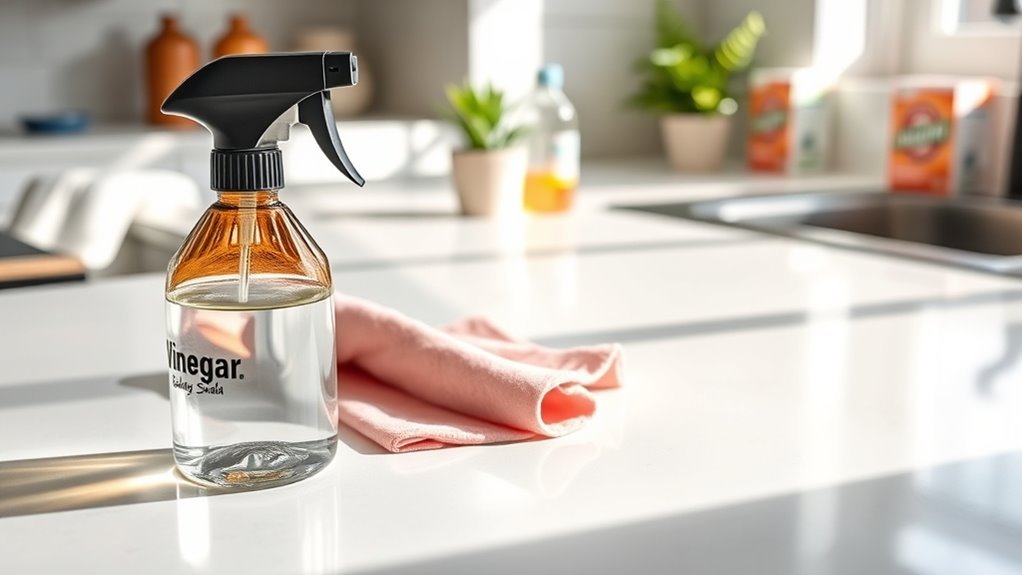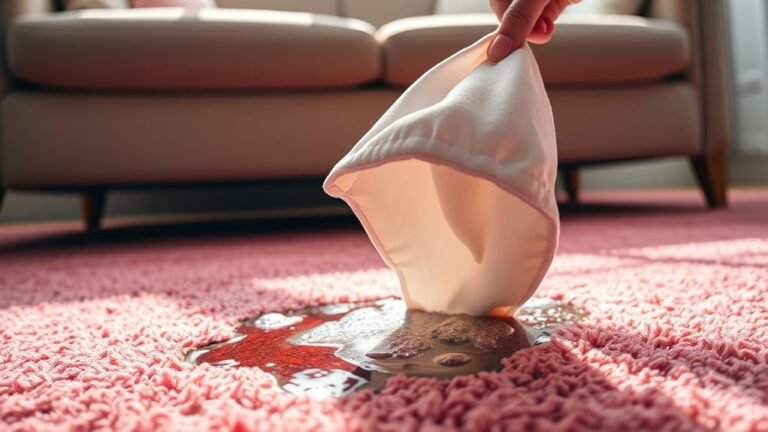How to Remove Stubborn Stains From Laminate
To remove stubborn stains from laminate, first identify the stain type—ink, grease, or food spills—to choose the best method. Use gentle household items like a baking soda paste or a vinegar solution to lift dirt without harming the surface. For ink or marker marks, try rubbing alcohol or a magic eraser carefully. Regular cleaning and quick spill response help prevent buildup. Discover more tips and tricks to keep your laminate looking spotless and lasting longer.
Identifying Different Types of Laminate Stains

Before you can effectively remove stains from laminate surfaces, you need to identify what type of stain you’re dealing with. Different types of stains call for different approaches, so knowing what you’re up against is key to maintaining your freedom from frustration. Common stains on laminate surfaces include food and drink spills like coffee or wine, ink marks, grease or oil stains, and even discoloration from sunlight. Each type interacts differently with the laminate’s finish, so guessing won’t get you far. Take a moment to observe the stain’s color, texture, and source. By accurately identifying the types of stains, you empower yourself to choose the right removal strategy without wasting time or damaging your surfaces. This way, you keep control and enjoy spotless laminate surfaces effortlessly.
Using Household Items to Tackle Stubborn Stains
You can often tackle stubborn laminate stains using common household items like baking soda, vinegar, or rubbing alcohol. It’s important to apply these safely to avoid damaging the surface, so always test a small area first. With the right techniques, you’ll keep your laminate looking clean without any harm.
Common Household Stain Removers
Though commercial cleaners are effective, you can often tackle stubborn laminate stains using common household items you probably already have. Baking soda is a fantastic, gentle abrasive—sprinkle it on the stain, add a bit of water to form a paste, then gently scrub with a soft cloth. For tougher spots, a vinegar solution made by mixing equal parts white vinegar and water can work wonders. Spray it on, let it sit for a few minutes, then wipe clean. These remedies offer you the freedom to clean without harsh chemicals, using simple, natural ingredients that are safe and accessible. Keep these staples handy, and you’ll be ready to handle most laminate stains quickly and effectively, without reaching for expensive products.
Safe Cleaning Techniques
Household items like baking soda and vinegar aren’t just convenient—they’re also safe choices for removing stubborn stains from laminate surfaces. You can mix baking soda with water to create a gentle paste that lifts stains without harsh chemicals. Vinegar, diluted with water, acts as a natural cleaning agent that breaks down grime effectively. These eco friendly products give you the freedom to clean without worrying about toxic residues or damage. When tackling stains, apply these solutions with a soft cloth or sponge, avoiding abrasive scrubbing that could harm the laminate. Choosing natural cleaning methods not only protects your home but also supports a healthier environment. Embracing these safe cleaning techniques means you get effective stain removal while staying true to eco friendly values.
Avoiding Damage Tips
While tackling stubborn stains on laminate, it’s important to use household items carefully to prevent damage. You want to maintain your laminate surface care by choosing the right cleaning product selection—avoid anything too abrasive or acidic, as these can dull or scratch the finish. Stick to gentle options like diluted vinegar or mild dish soap mixed with water. Always test a small, inconspicuous area first to verify no discoloration occurs. Use soft cloths or sponges rather than rough scrubbers to protect the surface. Avoid excessive water, which can seep into seams and cause swelling. By handling cleaning materials wisely, you keep your laminate looking fresh and extend its lifespan, giving you freedom from constant worries about damaging your floors or countertops while removing tough stains.
Applying Commercial Cleaners Safely on Laminate
Before you apply any commercial cleaner to your laminate, it’s important to read the label carefully to verify it’s safe for your surface. Check the commercial cleaner ingredients to verify none are too harsh or abrasive, as these can damage the laminate’s protective layer. Look specifically for cleaners labeled as compatible with laminate surfaces—this helps you avoid unwanted discoloration or warping. Always test the cleaner on a small, hidden area first to confirm it won’t harm your laminate. Use a soft cloth or sponge rather than scrubbing pads to apply the cleaner gently. By understanding the ingredients and verifying laminate surface compatibility, you maintain your freedom to clean effectively without risking damage, keeping your laminate looking fresh and stain-free.
Techniques for Removing Ink and Marker Stains

Ink and marker stains can be some of the toughest to remove from laminate surfaces, but with the right techniques, you can tackle them effectively. Start by gently dabbing rubbing alcohol or a hand sanitizer onto the stain using a soft cloth—these are proven ink removal techniques that break down the pigment without damaging the laminate. For marker stain solutions, a magic eraser works wonders; just dampen it slightly and rub the mark in a circular motion. Avoid harsh scrubbing to preserve your laminate’s finish. If stains persist, try applying a small amount of non-acetone nail polish remover, but test it in an inconspicuous spot first. By using these targeted methods, you regain control over your space and keep your laminate looking fresh and free.
Dealing With Grease and Oil Residue Effectively
When grease or oil residue clings to your laminate surfaces, it can be tricky to remove without leaving a greasy film behind. Start by applying grease absorbents like baking soda or cornstarch directly to the stain; let it sit for 10-15 minutes to soak up excess oil. Afterward, gently wipe it away with a soft cloth. If the stain persists, try oil solvents designed for delicate surfaces, but test in an inconspicuous spot first to avoid damage. Use a microfiber cloth dampened with warm, soapy water to remove any solvent residue. Avoid harsh scrubbing, which can scratch your laminate. With these simple steps, you can effectively tackle stubborn grease and oil stains, freeing your surfaces without compromising their finish or your cleaning freedom.
Preventative Tips to Keep Laminate Surfaces Stain-Free

Since preventing stains is always easier than removing them, adopting a few simple habits can keep your laminate surfaces looking pristine. Start with regular cleaning—wipe spills immediately and dust frequently to stop dirt buildup. Using mild, non-abrasive cleaners preserves the surface without damage. Applying protective coatings can add an extra barrier against stains and scratches, letting you enjoy your space without constant worry. Avoid placing hot items or harsh chemicals directly on laminate to prevent discoloration. By taking these straightforward steps, you maintain freedom from stubborn stains and keep your laminate surfaces fresh and inviting. Staying proactive means less hassle later, so invest a little time now for long-lasting beauty and ease. Your laminate will thank you with effortless durability.
Häufig gestellte Fragen
Can Laminate Scratches Be Repaired at Home?
You can totally handle laminate scratch removal with a bit of DIY repair! There are plenty of kits and products designed for this, like wax sticks, putty, or even markers that match your laminate color. Just clean the area, apply the product, and buff it out to blend the scratch. It’s a simple way to reclaim your freedom from costly repairs and keep your laminate looking fresh without calling a pro!
What Is the Best Way to Seal Laminate Edges?
To seal laminate edges effectively, you’ll want to create a strong edge sealing that acts as a waterproof barrier. Start by cleaning the edges thoroughly, then apply a clear waterproof sealant or edge banding adhesive designed for laminate. This prevents moisture from sneaking in and causing damage. You’ll enjoy the freedom of knowing your laminate stays protected, looking fresh without worrying about water ruining your work. It’s a simple step that keeps your space durable and carefree.
How Do Humidity Levels Affect Laminate Flooring?
Humidity hassles happen when high humidity levels lead to moisture damage on your laminate flooring. You’ll notice swelling, warping, or buckling because laminate isn’t immune to humidity effects. To maintain freedom from floor frustration, keep indoor humidity between 30-50%. Using dehumidifiers or air conditioners helps regulate moisture, preventing damage and ensuring your laminate stays flawless, free, and fabulous for years to come. Don’t let dampness dominate your delightful space!
Are Steam Cleaners Safe for Laminate Surfaces?
When thinking about steam cleaner safety for your laminate surface care, you’ll want to be cautious. While steam cleaners can sanitize, the high heat and moisture might damage the laminate’s protective layer, causing warping or swelling. It’s best to avoid using steam directly on laminate floors and stick to gentle, damp mopping instead. Protect your freedom to enjoy your flooring by choosing cleaning methods that won’t risk long-term damage.
Can UV Exposure Cause Laminate Discoloration?
You might not realize it, but prolonged UV exposure can silently sabotage your laminate’s look. Without proper UV protection, those vibrant surfaces can fade or yellow over time, robbing you of that fresh, free feeling. To keep discoloration at bay, consider window films or blinds that block harmful rays. By taking these steps, you’re not just preserving your laminate—you’re protecting your space’s spirit and your freedom to enjoy it fully.






